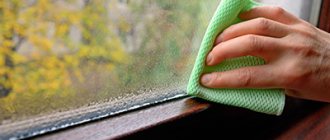A private home requires attention. This also applies to maintaining structures in good technical condition. This is important not only for load-bearing elements. For example, the same windows. Even minor problems in their operation can cause serious problems. For example, have you asked yourself the question, why do plastic windows in a house sweat from the inside in winter and what consequences can this lead to?
Fogging of windows is familiar to many users of private houses, as well as apartments. Many people do not pay attention to this, but this is wrong, as it can lead to some negative consequences. Let's look at the question of why condensation forms from the inside in more detail and how this problem can be solved with minimal costs.
What is the problem
What is the problem with foggy windows anyway? In general, condensation appears on windows as a result of a sharp temperature change. Conventional physics can explain this, or rather the transition of a liquid from a gaseous to a liquid state.
When there is a lot of vapor in the air, it turns into liquid when it collides with cold surfaces. The coldest point in the house is the window, so that's where condensation appears.
The windows are foggy from the outside. This situation is extremely rare
Oddly enough, windows can fog up in different ways.
Here are some of the most common scenarios:
- Condensation appears with the onset of cold weather. This situation is the most common; condensation forms when the temperature drops to a certain level. When the air temperature rises, the windows stop sweating
- The windows are sweating in the kitchen. This is natural, because the kitchen is constantly cooking. The temperature in the room is constantly changing, which leads to fogging of the window
- The window only sweats in one room. This problem occurs due to certain features of the room itself, or due to problems directly with this window
- The window only sweats in the morning. Closer to lunch, the condensation completely disappears, and the window remains dry
Using heating devices
Since one way to reduce fogging is to heat the surface of the window, heating radiators should always be located under the windows.
In this case, in addition to the ventilation device, it is advisable to install a convector under the French window, which is installed directly into the floor. This can be either an electric or a water device. When it works, warm air rises directly across the window glass, heating it and preventing the formation of condensation.
The same option can be used to heat ordinary windows. But since most often there is a window sill between the heating device and the window, which blocks the flow of hot air, you can use special flow grilles. They cut into the window sill as close to the glass as possible.
Why do windows sweat?
To understand how to solve the problem of window fogging, you need to find out what reasons can lead to this.
Flowers on the windowsill are one of the most common causes of condensation on windows
As a rule, this problem manifests itself for a number of the following reasons:
1 High level of humidity in the room. This problem often causes kitchen or bathroom windows to fog up. If there is high humidity in the room, condensation will form on the windows. Frequent cooking leads to a worsening of the situation, faulty ventilation or hood, drying clothes after washing.
2 Poor circulation of heat from various heating sources. This problem most often occurs in the fall or spring, when it is still cold and humid outside and the indoor temperature is not warm enough. Warm air does not enter the lower part of the window sill, especially if it is wide, and condensation forms in this place.
3 Incorrectly installed windows. Experienced installers carry out this work in accordance with all standards, so no problems arise. Those who charge less for work cannot guarantee a high-quality result; they are usually in a hurry and perform the installation with deviations from the norm. In such situations, the structure is not completely sealed, and cold air can penetrate into the middle of the room. Another problem during installation is level mismatch. Over time, the window frame warps and the seal is broken. This can cause problems not only in the formation of condensation, but also in the operation of the window as a whole: opening the sash, operating the fittings, etc. If you install it yourself, the scenario is approximately the same, without experience, if something goes wrong you won’t even be aware of this before the first signs of a problem appear.
4 Poor quality glass unit. This problem also often arises due to the desire to save money. Poor insulation or faulty fittings in windows allow cold air to enter, causing condensation to form.
5 Double-glazed window. This is the so-called cold glazing system, which is used only for non-residential premises. This design does not have sufficient thermal insulation properties, which leads to the appearance of condensation.
6 The fittings are not adjusted correctly. During seasonal temperature changes, the profile can expand and contract. Therefore, window fittings are adjusted according to the season. Otherwise, the seal of the window may be broken and it will begin to sweat.
7 The insulation has worn out or was initially of poor quality. All window structures are equipped with a seal, which is located along the contour of the sash. It tends to wear out or harden over time. In cheap models this happens faster, so the window “sweats”.
8 Clogged drain holes. You can find them at the bottom of the opening sash. Their purpose is to allow water to flow down the outside of the glass when the sash is in ventilation mode. When the drainage holes are clogged, water flows onto the windowsill indoors.
9 Plant on the windowsill. If the flowers are very close to the window, there is a high probability that condensation will begin to form. Plants release moisture or it evaporates after watering.
Reasons for fogging of windows in a wooden house
When the problem in question arises, you first need to understand why the windows in a wooden house sweat. The main reason for such troubles is the increased level of humidity that is created in the interior of the building. As a result of the temperature difference between the outer and inner surfaces of the window, moisture condenses on the glass. It is important to note that several factors contribute to an increase in humidity:
- use of gas equipment for heating the building;
- absence or insufficient level of insulation of the building;
- lack of ventilation and normal air exchange between the street and interior spaces of the house.
Article on the topic: How to lay tiles on a wooden floor in a bathhouse Quite often, the cause of fogging of window structures is the incorrect choice of thickness and other parameters of the double-glazed window.
It is important to note that it is equally wrong to use either an overly insulated option, as this will lead to additional costs, or one that has insufficient insulation characteristics. It is in the latter case that condensation is most likely to occur. If you discover a situation where windows in a wooden house are sweating, measures should be taken as quickly as possible to eliminate this phenomenon. Otherwise, constant exposure to moisture will inevitably lead to wet structures, not only the installed filling, but also adjacent wooden surfaces. As a result, rotting processes will begin quite quickly, mold and harmful microorganisms will appear. The logical consequence of this will be not only a decrease in the comfort of living, but also the danger of a negative impact on the health of the inhabitants of a residential building.
Dew point concept
Dew point is the temperature at which water changes from a gaseous state to a liquid. This point is located in the thermally insulating layer of the wall, and is located at different levels in different situations. This point cannot be detected visually; it is only marked on the graph.
The dew point is directly proportional to the humidity level in the room
The most important rule is that condensation forms due to temperature and humidity. The lower the humidity in the room, the lower the dew point.
Factors that influence dew point:
- outside temperature
- wall thickness
- room temperature
- indoor humidity
- humidity outside
Methods to reduce fogging
As we have already found out, the answer to the question of why plastic windows sweat in a private house is high humidity and low surface temperature of the structure. To fix the problem, you need to remove excess moisture and increase the temperature of the window. By what methods is this done?
Ventilation and dehumidification are used to reduce humidity levels.
Increasing the temperature on the inside of the glass unit is achieved by using special heating devices or replacing windows with more energy-efficient ones.
Why do you need to remove condensate?
Complete sealing of plastic windows can disrupt the natural microclimate in the room. While wooden structures can “breathe,” completely sealed PVC windows prevent natural air circulation.
Condensation is one of the reasons for the appearance of fungus
If condensation forms on the windows, then the microclimate in the room is unfavorable for human health. Because of this, pathogenic bacteria, fungus and mold can develop in the room.
For a person, ideal living conditions are considered to be 20-22 degrees Celsius and 30-45% humidity in the room. Condensation on the windows is the first sign that the atmosphere in the room does not meet these requirements. To return a favorable atmosphere to the room, this problem must be eliminated.
How to prevent windows from fogging up
Preventing the formation of condensation on a window is a less expensive and more effective procedure, since the consequences of window fogging are unpleasant and dangerous. Ice forms on the window and windowsill, which is an additional source of cold and contributes to an increase in the number of colds. Constant humidity leads to the appearance of fungus, mold and other bacteria that are difficult to remove. To prevent this from happening, take preventive measures:
- Reduce the width of the window sills;
- Remove pots with indoor plants from the windowsill;
- Install a cross-ventilation valve under the windowsill;
- Ventilate the room frequently or set the window sashes for constant micro-ventilation.
Article on the topic: The best way to sheathe the outside of a wooden house reviews
Eliminating the cause of fogging of a plastic window will preserve the health of family members, eliminate a visual defect and add comfort.
Condensation and wooden windows
As a rule, in houses with wooden windows the problem of fogging is not known. This is due to the structure of the wood itself, which allows air to circulate and they are not as airtight as plastic ones. This way the room maintains a normal level of humidity.
Wooden windows rarely sweat, but if this problem occurs, immediate action must be taken
Modern window designs are completely sealed. On the one hand, this is good, because the room becomes much quieter and warmer after their installation. This prevents air from circulating as it was originally intended.
To get rid of condensation, sometimes it’s enough just to ventilate the room daily. This will help natural air circulation and prevent fogging. In addition, some modern window systems have special channels for micro-ventilation. But wooden windows can also sweat, but why does this happen?
Why do wooden windows sweat?
Using a fan heater, you can blow off foggy windows
As in other cases, the first reason for the formation of condensation is excess humidity in the room. If the air humidity is more than 50%, this is immediately reflected in fogged windows.
To get rid of condensation on the windows, arrange for them to be blown with warm air. To do this, you can use a heat gun, fan heater, air dehumidifier, etc.
Incorrect installation of radiators can also cause this problem. If the radiator is located far from the windows, it will most likely not be possible to completely get rid of the appearance of dew. For normal air circulation, the radiator will have to be placed in the correct place. In addition, a cold wall that is not heated by a radiator will also cause frost to form on the window.
What is the danger of moisture on windows?
First, let's find out the importance of the problem. Maybe you shouldn’t wonder why plastic windows sweat and leak and not try to solve this issue? So, the main dangerous moments that can arise with frequent formation of moisture on the surface of enclosing structures are:
- with heavy condensation, water can fall on the walls and floor covering, destroying them;
- high humidity in the area of the wall near the window opening can become a good environment for the occurrence and development of a fungal infection: the wall and window turn black, fungal spores spread throughout the room;
- When using electric heating devices, water from the windowsill may fall onto them, causing malfunctions in their operation.
Now let's try to figure out why plastic (metal-plastic) windows sweat and what to do in this case. We will also consider the issue of fogging of wooden windows.
Condensation between glasses, what to do
If condensation at the bottom of a plastic window, or along its entire surface on the inside of the window, is a common occurrence, then fogged windows from the inside are much less common. Most often this occurs due to depressurization of the structure.
Condensation inside the glass unit
This may happen for the following reasons:
- The product was released with a defect . This happens when they want to save money when purchasing and buy windows from an untrusted manufacturer. Another reason may be a violation of window manufacturing technology.
- window damage during transportation . If, during transportation of the product, chips or cracks appeared on the window, the gas or compressed air that fills the space between the double-glazed windows could escape. It could also be possible to remove the layer of sealing sealant.
- if the owner of the windows carries out some manipulations with the product , disassembles them and puts them back together, the gas also comes out, and after assembly it was not sealed back. If a glass unit was disassembled, its original properties were lost in 90% of cases
If condensation begins to form between the glasses, the only solution is to completely replace the double-glazed window with a new one. A professional can replace a double-glazed window in just half an hour, but you can do this work yourself. In addition, a new double-glazed window is not expensive at all.
Useful tips on how to deal with condensation
Regular ventilation is important to prevent “dew on the windows” and for human health.
Sometimes a problem catches you by surprise, and you have to look for a solution literally on the fly.
If for some reason it is not possible to find the root of the problem, professionals recommend preventing window fogging using the following recommendations:
- If condensation appears on your windows, first of all you should remove all plants from the windowsill. Plants evaporate moisture, which is when problems arise.
- Ventilate your apartment regularly. Spend 10-15 minutes daily on this, let it become a kind of ritual
- You need to install a hood in the kitchen. With its help, most of the moisture that appears during cooking will be absorbed. This will help reduce the humidity level in the room itself and prevent condensation. You also need to adjust the draft of the device; if it is too strong, the result may be the opposite.
- Windows need to be inspected regularly for damage. Carefully check the fittings once a year and the seals for wear. If necessary, faulty parts must be replaced
- Once a season, the fittings must be switched to winter or summer mode
- try to increase the air temperature in the room. In some situations, this is enough, and when the temperature stabilizes, condensation stops forming
- make a window sill already. This is relevant if “dew” appears mainly at the bottom of the window. This means that the heat from the battery does not reach this area
- make an additional hole for ventilation under the window sill. It must be end-to-end. Additional ventilation will increase air circulation and possibly prevent condensation.
Ventilating the room can not only help combat condensation, but will also be beneficial for the health of the inhabitants of your home.
The causes of condensation can be completely different. In some cases, the problem is minor, for example the same flowers. Therefore, before taking drastic measures, it is worth taking these preventive actions.
Tears for summer: why is fogging of plastic windows a common occurrence in autumn? (2 photos)
Many people experience the problem of windows sweating in the fall. In addition to a purely aesthetic problem, this phenomenon can lead to damage to the glass unit and even illnesses to the inhabitants of the house or apartment. How to find out and eliminate the root cause of an unpleasant phenomenon?
Why does condensation form on double-glazed windows?
When the temperature outside the window drops, the risk of a kind of “tears” – condensation – appears on the glass. What causes this process? Very often the reason is the unprofessionalism or dishonesty of the installers. But even if the work is done to the highest possible quality, moisture on the windows, which after settling can lead to the formation of puddles on the windowsill and even the development of fungus on the slopes, can be caused by the following factors:
1. Problems with indoor air circulation. If, as the temperature outside decreases, the batteries have not yet warmed up sufficiently, and it is already very cold outside, then condensation may appear due to the temperature difference.
2. Specifics of the window sill design. Too much overhang can prevent warm air from flowing away from the battery. Accordingly, the window will not heat up, which will lead to drops appearing on the glass.
3. The presence of a protective screen on the battery.
4. Ineffective ventilation. If there is no air circulation in the apartment, all the moisture generated will remain indoors.
5. Excess moisture. It can be provoked by drying clothes in the room, cooking and other factors.
6. Freshly renovated. The finishing and decorative materials used retain the ability to release moisture for some time, which leads to sedimentation on the glass.
7. Poor quality material, due to which the windows do not close tightly.
8. Distortion that appears when double-glazed windows are installed incorrectly.
Article on the topic: What landscape design goes with a wooden house
What to do to prevent autumn fogging of windows?
Before choosing one or another solution, it is necessary to correctly identify the problem. First you need to check the air circulation. To do this, you can simply attach a sheet of paper to the ventilation mesh. If it holds tightly, then everything is fine with ventilation. If the fit is not tight, it is necessary to check the permeability. Poor convection can be caused by overly thick and heavy curtains that impede air circulation. The problem can also be caused by an excessively large projection of the window sill, which prevents uniform heating.
Potted plants can also make windows “cry,” since excess moisture from watering can cause condensation. Therefore, for the winter it is better to remove them from the windowsill indoors. After installing the windows, it is necessary to well insulate the openings between the windows and the walls using polyurethane foam, polystyrene foam or mineral wool. There should be no gaps, since even if they are small, cold air will get inside and cause problems.
It is imperative to install a good hood in the kitchen, since it eliminates not only odors and excess moisture during cooking, but also promotes air circulation. Before the onset of the autumn season, it is also advisable to check the fittings on the windows, since rubber and plastic wear out quite quickly. Accordingly, due to small areas of blowing and temperature differences, moisture may appear, and, subsequently, fungus. As a preventive measure, you can treat the glass with alcohol, glycerin, or a special spray for cars.
Mold is a companion of foggy windows, what to do about it
Mold must be dealt with immediately
One of the most unpleasant consequences of frost on windows is mold. If you do not pay attention to the formation of condensation and start the problem, this can lead to more serious consequences, or rather, fungus and mold. And what to do when the slopes are covered with mold?
When you notice the appearance of black spots around the windows, you should take care of removing this plaque. To do this, you can use various chemical compounds, including bleach or an alcohol solution. After removing plaque, you need to make it a rule to regularly ventilate the room. Such precautions are taken only in winter.
With the onset of warmer weather, it is necessary to take more serious measures and completely remove mold-affected areas of plaster and replace it with new one. After the new layer has dried, it must be treated with an antiseptic.
Ways to remove fogging from windows
Understanding the causes of window fogging helps in correcting the situation. The main ways to eliminate window fogging include:
- If condensation forms inside the glass unit chamber, the only way to eliminate it is to replace the glass unit. Invite specialists to carry out the replacement procedure efficiently so that such a nuisance does not happen again.
- Check the evenness and latching force of the window sash. Run your hand along the line of the end of the sash when it is closed, hold a lighted match - the presence of a draft indicates a loose fit. In this case, adjust the sash using screws and pressure plates.
- If the issue of installing double-glazed windows is relevant at the moment, choose the width of the window sill so that it does not block the heating radiator. If the window sill is already wide, make holes in it and install ventilation grilles.
- Finishing the slopes helps eliminate the problem of condensation on the window. Contact the company you ordered the windows from and make sure that insulation is installed under the slopes.
- High humidity and poor ventilation are interrelated problems. By correcting the ventilation in the room, the problem of humidity and excessive condensation will go away.
- Check the window fittings and, in particular, pay attention to the sealing tape. If necessary, replace it with a new one.
- If for any reason single-chamber double-glazed windows are installed in the apartment, it is necessary to carry out additional insulation (insulating the slopes and applying energy-saving film to the double-glazed window) or replacing the double-glazed window with a two-chamber or three-chamber version.
How to get rid of condensation using traditional methods
To combat condensation, you can use traditional methods. They are more gentle on the structure itself, but these methods effectively cope with the problem.
Method 1
An old and proven way to deal with “dew” and ice on the window is a candle.
An ordinary wax candle can help in the fight against fogging of windows. It works in the case of double-glazed windows and the formation of frost on the windows. This method has been used for several decades; this method has been used to remove ice from windows. Several candles are placed on the windowsill along its entire length. They warm up the glass and prevent ice from forming.
Many people recommend using thick candles. They burn slower and will last longer. At the same time, with the help of such candles you can “brighten up” the interior of the room a little, making it more comfortable. If desired, candles can be scented.
When a candle burns, it releases carbon dioxide. If there are indoor plants on the windowsill, this can be an excellent feed for them, and you won’t have to remove the flower pots.
Method 2
Properly washed windows will prevent condensation from forming. But for this you need the right solution
Sometimes cleaning your windows properly can help. Depending on the original cause of condensation, sometimes this is enough. Of course, the “success” of such a struggle can be expressed in varying degrees, but sometimes it helps.
For washing you need to use:
- soft, lint-free cloth
- microfiber cloth
- newspapers for wiping
- soap solution
- glycerol
- alcohol (you can use vodka)
- shaving foam
- car window anti-fog spray
- rubber scraper
A window with a fatty layer is most likely to fog up. That is why the “fight” against condensation must begin by cleaning the windows with alcohol.
This will degrease the surface, and the work is carried out as follows:
- first of all, the windows need to be washed in the usual way using a soap solution
- glass must be wiped dry with a lint-free cloth
- remove remaining moisture from the surface using a rubber scraper
- Alcohol is applied to the sponge and the entire surface of the glass unit is treated with it.
- waiting for the window to dry completely
This way, the surface of the window will be completely degreased, which will prevent condensation from forming for some time.
Anti-fog saline solution
The saline solution is applied to a pre-washed window
1 You need to prepare the solution itself. To do this, take 4 liters of water and dissolve 1 tbsp in them. l.
2 Wash the glass in advance with a soap solution , and after it dries, apply the solution evenly.
If there is too much salt, white streaks will remain on the glass after drying. In this case, the entire procedure will have to be repeated from the very beginning.
Glycerin solution
It will be no less effective in case of fogging.
To do this you will need:
- Alcohol and glycerin are mixed in a ratio of 10/1.
- The solution is applied to a previously cleaned glass surface and left for some time. After some time, the alcohol will disappear, and the glycerin will remain on the surface of the glass as a protective film.
Potassium oil, glycerin and turpentine
First you need to prepare the solution itself.
To do this, mix:
- 40 g potassium oil
- 4 g pine turpentine
- 20 g glycerin
The mixture will be quite thick, but it must be applied to pre-washed glass using a sponge. Apply the product in an even layer, distributing it over the entire surface. Using a woolen cloth, polish the glass until it shines.
Method with newspaper
Cleaning a window with newspaper
Many generations before us used crumpled newspapers to clean windows. They help to completely clean the glass surface from dirt and soap stains.
At the same time, few people know about the “miraculous” property of printing ink, which gives the treated glass a water-repellent effect:
- wash windows with soapy water
- start polishing them with crumpled newspaper
Chalk
Chalk solution (you can use tooth powder, it must be white), dilute it with water and treat the pre-washed window. After treating the surface, it must be washed to prevent streaks from appearing.
Anti-fog chemicals
Window cleaner “Sekunda”
Folk remedies do not always help as much as they should, and then you have to look for other ways to combat this problem. Modern household chemicals are another simple way to combat window fogging.
All chemicals that are designed to combat condensation work on the same principle. The composition is applied to the glass surface and left for a certain amount of time (which is indicated on the packaging; this period is different for all products). After this, wipe the window dry using a lint-free rag.
Tested chemicals:
1 "Li-lo." An effective remedy for fogging and freezing of windows. The product is very concentrated, so you must wear gloves when working. You can buy it at most hardware stores. Apply a thin layer of the product to the surface of the glass; for this you can use a dish sponge. After this, you need to treat the surface a second time with the already diluted product. We dilute “Li-lo” with water in a ratio of 10/1. Without washing off the previous layer, apply the diluted product and do not wash off. We are waiting for it to dry completely.
2 "Second". The product is sold in aerosol form, making it much easier to apply. It is evenly sprayed over the surface in several layers. After this, the glass must be thoroughly wiped with newspaper.
How to wipe windows to prevent sweating inside in winter
To eliminate condensation, you need to choose the right window demisting agent:
- A wax candle is the most common folk remedy for normalizing the climate in a room. Place several candles on the windowsill so that they continue to burn all day and warm the glass. Due to air convection from the flame, condensation does not settle on the glass. As a result of the combustion procedure, carbon dioxide, which is beneficial for plants, is released, so the greens can be left on the windowsill. Pay particular attention to safety and remove items that could easily catch fire.
- Soap . “Rub” a mesh with small cells on the glass with toilet soap. Smear the marks until shiny with a clean microfiber cloth.
- Glycerin . Combine ethyl alcohol with glycerin until smooth in one container, based on the proportions 20/1. Pour the composition into a spray bottle and treat the glass. Polish any stains dry. When the processing is completed, the alcohol will evaporate, and a thin film of glycerin will remain on the glass for a long time.
- Shaving foam . Squeeze a thin layer of foam or gel onto the glass, wipe with paper or a napkin until it shines.
- Dry windows can be wiped with the pulp of half a cut lemon , after which the surface is treated dry with a towel.
- Salt . A cloth bag filled with salt is placed between the doors. The grains will absorb excess moisture well.
- Toothpaste . Apply toothpaste to a sponge or microfiber cloth and vigorously wipe the glass dry. You can also clean the surface with tooth powder.
Important! It is better to burn thick scented candles that burn for a long time and bring a touch of comfort to the interior of the room.
A little about window ventilation
The same comb on the window
As mentioned above, most often the most effective way to combat the formation of frost on glass is high-quality ventilation. The window structure must be equipped with ventilation.
- Windows with a window. Today, windows with a window are extremely rare; they are made only according to the individual orders of the buyers themselves. But this design is most effective in combating condensation. The flow of cold air from the street is easily regulated; it penetrates into the room at the top of the room, where it combines with warm room air. This improves the microclimate in the room.
- Micro-ventilation. It has already been mentioned before, now let’s look at this method of ventilation in more detail. This is the name of the ventilation mode, which is found in almost all modern window designs. The window opens just a little, leaving a small gap through which air exchanges. Through this gap, a lot of cold air will not be able to penetrate into the room, so ventilation in this mode will not bring discomfort to the inhabitants of the house, even in cold weather.
- Self-ventilation. This function is initially present in all window designs. It consists of many small holes in the lower and upper frames of the window. Air circulation eliminates fogging, cold air enters in the lower part, and air leaves the room through holes in the upper frame.
- Combs on the windows. A comb is an accessory for plastic windows that can be purchased at any specialized store. It helps regulate the intensity of ventilation and opening of the sash.
- Ventilation duct. Many people neglect to install it right away, and install it only after a problem appears. Such a ventilation duct is installed either under the window sills or in the profile itself. The devices are completely different. The cost of such a channel is quite high, so ventilation installation should be done by a professional.
Useful tips
To effectively combat the appearance of moisture on windows, you can use useful life hacks:
- Installation of ventilation devices or double-action air conditioning to improve the ventilation process in the room.
- If the humidity level is slightly exceeded, place air drying devices on window sills or nearby.
- Using a hood when cooking: combating steam from cooking food will become much more effective.
- Limiting activities that increase humidity: long baths, drying clothes indoors.
- During renovation work, the relative humidity inside the room increases and the windows fog up. To prevent the problem, you need to isolate the window volume. Use construction tape to seal the opening with plastic film. Open the window sash slightly, and the moisture will settle on the film and not on the glass.
Article on the topic: How to calculate a wooden staircase in a house
To prevent windows from freezing and mold around the frame, it is important to achieve the correct humidity and air circulation in the room.
Other ways to eliminate condensation
Convection screens will help in the fight against condensation
But chemistry and folk remedies are not all that help cope with the problem of window fogging.
Of the other methods, the most effective are:
- Using a fan, you can create air circulation in a room near a window. The device is placed on one of the window sills, and its direction should preferably touch several window sills at once.
- Convection screens. This is a special device that directs a flow of warm air to the window and prevents condensation from forming. These screens need to be installed at an angle of 30-60 degrees. If the method turns out to be effective in your case, the device can be decorated in accordance with the overall interior of the room.
- Electricity against dew on windows. This method is considered extraordinary, but in most cases effective. Foil, nichrome thread, or other material that conducts current is attached around the perimeter of the entire window. They operate at a voltage of 12-24 W. This solution warms the windows and prevents condensation from forming.
Causes of window fogging
The reasons for the formation of condensation lie in the physical properties of water. Being in a gaseous state, water is not noticeable, but when heated, the steam reaches the “dew point” - the stage at which the gaseous state gives way to a liquid state. For this reason, it is almost impossible for a window to fog up from the outside; for this to happen, it must be colder in the apartment than outside. There is only one reason for the formation of condensation inside a double-glazed window - broken sealing of the structure. When depressurization occurs, warm air enters the glass unit, which, when cooled, settles on the window as drops of water.
There are more reasons for fogging of the window on the side of the room. Let's look at the main ones.
- A single-chamber double-glazed window will not provide sufficient thermal insulation and is not recommended for installation in residential premises.
- If the air humidity in the room is high, excess steam will settle on the windows.
- The window sill is too wide and blocks the flow of warm air coming from the radiator; the double-glazed window does not warm up.
- If there is no ventilation in the room, windows will fog up regularly.
- Violations of the installation technology of plastic windows. This includes improper sealing of the window using polyurethane foam, missing or incorrect installation of slopes, defective fittings and wear of the seal. All these reasons lead to disruption of the functioning of plastic windows.
Article on the topic: When to paint a wooden house










